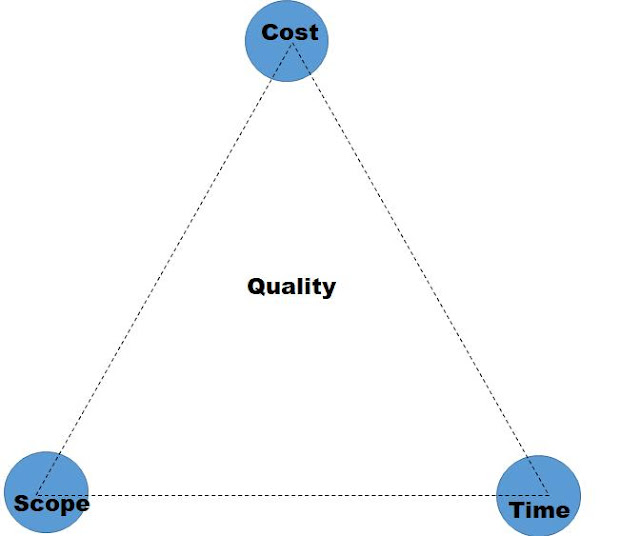The
project management triangle is the 3 constraint model, which is time, cost, and
scope. These 3 elements are inherent while managing a project. Every project
manager has to work around these constraints along with various other factors
for the success of a project. The three constraints are interdependent. Change
in one constraint will impact the other two. If you change the scope of a
project, it will impact time and cost. Similarly, if the deadline is reduced,
it can lead to increase in cost and narrowing the project scope. All the
factors of the Project Management triangle contribute towards the quality and
result of the project.
The
Project Management triangle is also known by the name Triple Constraint, Iron
Triangle, and Project Triangle. The success of the project is quite dependent
on how the 3 constraints are managed by a project manager. Let’s have a look
into each of these constraints:
Time
Every project has a set timeline. It has a start date and a closing date.
A project manager has to work on these timelines to complete the project. A
fixed schedule will help project managers to decide when the project will reach
certain milestones. Though it is important to adhere to the timelines, project
managers are in circumstances where they have to alter them. The reasons for
altering the timelines can be due to technical issues, delay in receiving
supplies and raw materials, and change in deliverables.
There
are times when project managers predict wrong deadlines, which impacts the
success of a project. There are also times when clients require a project to be
completed earlier than the proposed deadline. For instance, the finalized
deadline set by the client to complete the project was May. Later, the client
changes the launch date to April. The project managers will have to change the
schedule of the project, which will impact the scope and cost to complete the
work before the new deadline.
Cost
Every
project requires a budget, and its success is depended on the estimated budget.
The project manager proposes a budget by estimating the costs involved in a
project. The factors that impact the costs are fluctuations in the
international market, the increase in prices of raw materials and other
supplies, and the cost of buying new technology or software. Though the project
manager estimates the cost, there are times when the budget of a project may
increase or decrease during the different phases of the project. The success of
a project is depended on how effectively these predictions are made by the
project manager. The fluctuations in the cost will have a deep impact on the
success of the project. It will also affect the deadline when the project will
be completed and the scope of the project.
Scope
In
any project, the scope is an integral part of the triangle. It is crucial for
project managers to predict the scope accurately. It will help the stakeholders
and clients understand the impacts the scope will have if they make changes to
the deadlines and budget during the phase of the project.
Therefore,
the three constraints are crucial for a project manager to estimate the right
budget, deadline, and scope. Changes in any of these elements can impact the
project or lead to impacting the quality of a project. Tightening the deadline
or cost can lead to delivering a poor quality product or the scope of the
project. Though these are three important elements of the Project Management
Triangle, project managers have to consider many other factors during the life
cycle of a project.
It
is not easy for a project manager to manage a project without making accurate
estimations and predictions. The project management certification prepares
project managers and develops the right skills to understand the scope, cost,
and time required for a project. They also need to have an understanding of
various other factors like managing resources, risks, products, and so on. The
understanding of how to manage a project and the right skills help in their
role to be successful with the project planning and execution.
Certification
Planner is a leading training provider for Project Management courses. To know
more about the various Project Management courses email us at support@certificationplanner.com or
call us at 855.322.1201 or visit us at www.certificationplanner.com.



Comments
Post a Comment